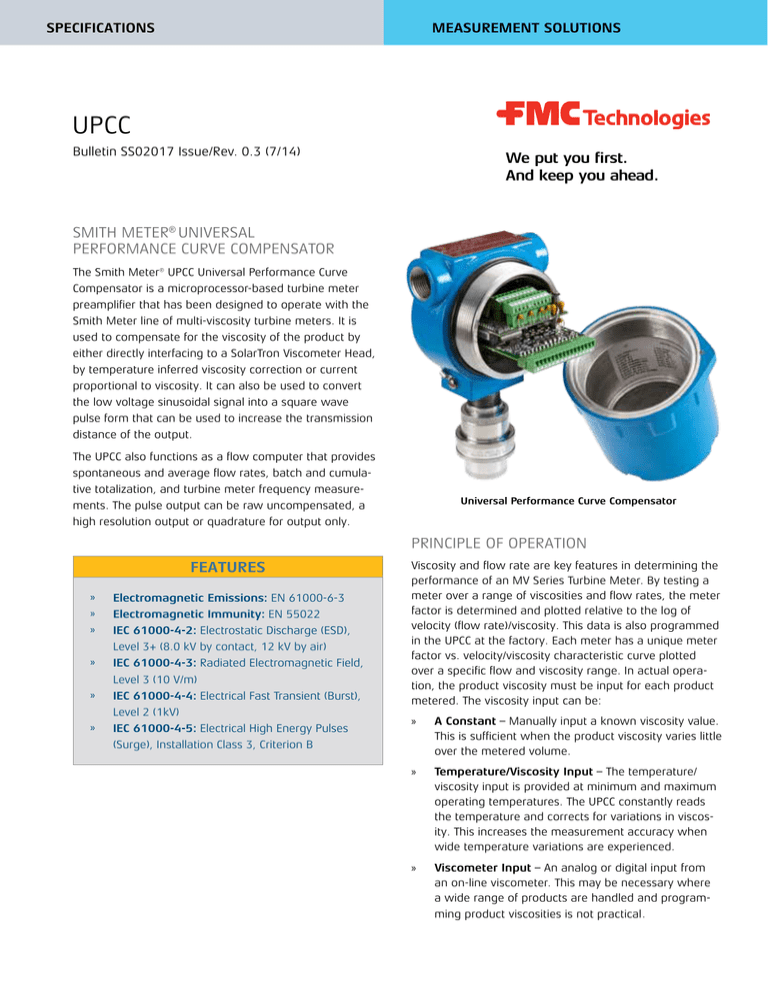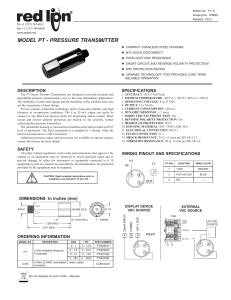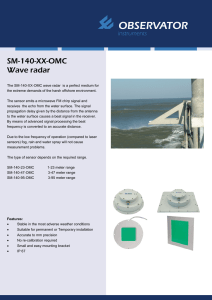
SPECIFICATIONS
MEASUREMENT SOLUTIONS
UPCC
Bulletin SS02017 Issue/Rev. 0.3 (7/14)
We put you first.
And keep you ahead.
SMITH METER® universal
performance curve compensator
The Smith Meter® UPCC Universal Performance Curve
Compensator is a microprocessor-based turbine meter
preamplifier that has been designed to operate with the
Smith Meter line of multi-viscosity turbine meters. It is
used to compensate for the viscosity of the product by
either directly interfacing to a SolarTron Viscometer Head,
by temperature inferred viscosity correction or current
proportional to viscosity. It can also be used to convert
the low voltage sinusoidal signal into a square wave
pulse form that can be used to increase the transmission
distance of the output.
The UPCC also functions as a flow computer that provides
spontaneous and average flow rates, batch and cumulative totalization, and turbine meter frequency measurements. The pulse output can be raw uncompensated, a
high resolution output or quadrature for output only.
Universal Performance Curve Compensator
Principle of Operation
FEATURES
»»
»»
»»
»»
»»
»»
Electromagnetic Emissions: EN 61000-6-3
Electromagnetic Immunity: EN 55022
IEC 61000-4-2: Electrostatic Discharge (ESD),
Level 3+ (8.0 kV by contact, 12 kV by air)
IEC 61000-4-3: Radiated Electromagnetic Field,
Level 3 (10 V/m)
IEC 61000-4-4: Electrical Fast Transient (Burst),
Level 2 (1kV)
IEC 61000-4-5: Electrical High Energy Pulses
(Surge), Installation Class 3, Criterion B
Viscosity and flow rate are key features in determining the
performance of an MV Series Turbine Meter. By testing a
meter over a range of viscosities and flow rates, the meter
factor is determined and plotted relative to the log of
velocity (flow rate)/viscosity. This data is also programmed
in the UPCC at the factory. Each meter has a unique meter
factor vs. velocity/viscosity characteristic curve plotted
over a specific flow and viscosity range. In actual operation, the product viscosity must be input for each product
metered. The viscosity input can be:
»»
A Constant – Manually input a known viscosity value.
This is sufficient when the product viscosity varies little
over the metered volume.
»»
Temperature/Viscosity Input – The temperature/
viscosity input is provided at minimum and maximum
operating temperatures. The UPCC constantly reads
the temperature and corrects for variations in viscosity. This increases the measurement accuracy when
wide temperature variations are experienced.
»»
Viscometer Input – An analog or digital input from
an on-line viscometer. This may be necessary where
a wide range of products are handled and programming product viscosities is not practical.
Specifications
Analog (4-20mA)
Electrical Inputs
DC Power1
12 to 24 Vdc +/- 10%2
Switch: 5-36 Vdc
Current Consumption: Less than 250 mA at 24 volts
Type: Two-wire, 4-20 mA current loop receiver, isolated
from ground
Span Adjustment: Program adjustable through communications
Input Impedance: 50 Ω
Accuracy: +/- 0.05% of range
Resolution: One part in 65,536
Voltage Drop: Two volts maximum
Sampling Rate: One sample / second minimum
Input Signal
Type: Sinusoidal, no DC offset
Sensitivity: 70 mVp-p at 25° C and 10 Hz
Frequency Range: 2000 Hz maximum
Mode: Single
Type: Square wave, no DC offset
Sensitivity: 24 Vp-p
Frequency Range: 2000 Hz maximum
Input Impedance
10 k Ω minimum at 20 Hz
Status Inputs (3)
Type: One 4.7k Ω resistor in series with isolator diode
Input Voltage Range: 4-36 VDC
Pickup Voltage: 4 VDC maximum
Dropout Voltage: 2 VDC maximum
Current: 10 mA maximum
Common Mode: +/- 250 VDC to chassis ground
Transient Protection: 39 volt Zener diodes
Resistance (Temperature)
Type: Four-wire 100 Ω platinum resistance temperature
detector (PRTD)
Temperature Coefficient at 32° F: 0.00214 Ω/Ω/° F
(0.00385 Ω/Ω/° C)
Temperature Range: -148° F to 572° F (-100° C to 300° C)
Temperature Measurement Accuracy: Fluid temperature is
measured to within +/- 0.72° F (+/- 0.4° C) over the fluid
temperature range of -148° F to 572° F (-100° C to 300° C)
Fluid temperature is measured to within +/- 0.45° F
(+/- 0.25° C) over the fluid temperature range of 32° F to
572° F (0° C to 300° C)
Stability: 0.1° F (0.06° C)/year
Self-calibrating: Lead length compensation that requires
no resistance balancing of leads
Electrical Outputs
Pulse Outputs
Type: Push-Pull driver (current sink or current source).
Two raw, two programmable
12 VDC input power supply:
No load: 7 Vp-p minimum square wave
270 Ω load: 4 Vp-p minimum square wave
24 VDC input power supply:
No load: 14 Vp-p minimum square wave
270 Ω load: 11 Vp-p minimum square wave
Sink Current: 240 mA at 24 Vdc maximum
Source Current: 80 mA at 24 Vdc maximum
Frequency Range: 0 to 2000 Hz at 50/50 duty cycle
Switch Outputs
Type: Two open-collector transistors
Voltage Range: 6-36 VDC
Sink Current: 240 mA at 24 VDC maximum
Source Current: 80 mA at 24 VDC maximum
Common Mode: +/- 250 VDC to chassis ground
Transient Protection: 39 Volt Zener diodes across
Darlington transistors
Analog (4-20 mA)
Type: Two, two-wire, 4-20 mA current loop transmitters
Accuracy: +/- 0.25% of range
Resolution: One part in 65,536
Span Adjustment: Program adjustable through
communications
Environment
Ambient Operating Temperature: -58° F to 158° F
(-50° C to 70° C)3
Ambient Storage Temperature: -58° F to 185° F
(-50° C to 85° C)
Humidity: 0 to 95% non-condensing
1 DC power available from Smith Meter Electronics
Instrumentation.
2 When used with the SolarTron Viscometer Head,
the DC input power must be 24 Vdc.
3 For operation below -20° C, input power must be 24 Vdc.
2
Bulletin SS02017 Issue/Rev. 0.3 (7/14)
Communications
General
Configuration: Dip switch selectable between EIA-485 and
EIA-232
Data Rates: Programmable to asynchronous data rates of
1200; 2400; 4800; 9600; or 19,200 bps.
Data Format: One start bit, one stop bit, programmable
seven or eight data bits — even, odd or no parity.
Data Structure: Modicon Modbus protocol with two modes
of transmission (ASCII or RTU).
EIA-232
Configuration: Three-wire (Tx, Rx, GND); non-multidrop.
Transient Protection: 60 V (bd) bidirectional transorbs
across Tx and Rx lines; 1.5 kV maximum
EIA-485
Configuration: Half duplex; jumper selectable
Termination: Dip switch selectable 120 Ω termination
resistors of multidrop capabilities
Transient Protection: 60 V (bd) bidirectional transorbs
across Tx lines and across Rx lines, 1.5 kV maximum
Approvals
Electrical
UL/CUL, UL File E23545, Listed 557 N - Class I Groups
C and D; Class I, Zone I, Group IIB; Class I, Zone I, AExd
IIB T6 IP66; UNL-UL ENCL. 4, CNL-CSA ENCL. 4; Tamb
-50°C to 70°C
ATEX/IEC Ex - PTB 10 ATEX 1039X / IEC Ex PTB
10.0052X – Ex d IIC T6 Tamb -40°C to 70°C IP66
Essential Health and Safety Requirements
EN/IEC 60079-0: Electrical apparatus for potentially
explosive atmospheres – General requirements
EN/IEC 60079-1: Electrical apparatus for potentially
explosive atmospheres – Flameproof enclosures 'd'
EN 60529: Degrees of protection provided by enclosures
(IP code)
EMC Compliance: (by Council Directive 2004/108/EC)
Electromagnetic Emissions: EN 61000-6-3
Electromagnetic Immunity: EN 55022
IEC 61000-4-2: Electrostatic Discharge (ESD), Level 3+
(8.0 kV by contact, 12 kV by air)
IEC 61000-4-3: Radiated Electromagnetic Field, Level 3
(10 V/m)
IEC 61000-4-4: Electrical Fast Transient (Burst), Level 2
(1kV)
IEC 61000-4-5: Electrical High Energy Pulses (Surge),
Installation Class 3, Criterion B
Signal Cable
Distance
Wire Size
Resistance/Foot
Up to 2400 ft.
(731m)
#20 AWG
0.010150 Ω/ft
Up to 3800 ft.
(1158m)
#18 AWG
0.006385 Ω/ft
Up to 6000 ft.
(1828m)
#16 AWG
0.004016 Ω/ft
Note 1. Cable loop resistance should be limited to 50 Ω
maximum.
Note 2. Loop resistance = 2 times (cable length m/feet)
times resistance in Ω/foot of cable.
UPCC Modeling
UPCC --XU --STD
Model Designation
UPCC - Universal PerformanceFirmware
Curve Compensator
STD - Standard
Housing Type
XU - UL/CUL Listed
XC - ATEX / IEC Ex Certified
Bulletin SS02017 Issue/Rev. 0.3 (7/14)
3
Terminal Connections
16 Pin Connector
1 - DC Power Supply In (+)
2 -Common
3 -Pulse Out #3
4 -Pulse Out #4
5 - Pickup #1 (+)
6 - Pickup #1 (-)
7 - Not Used
8 - Not Used
9-
10 - Status In #1 (+)
Status In #1 (-)
11 - 12 - 13 - Switch Out #1 (+)
Switch Out Common (-)
Switch Out #2 (+)
14 - 15 - 16 - RS-232/Rx-485 (+)
RS-232/RX-485 (-)
RS-232 GND
Figure 1. Main Board
J2 Connector
JI Connector
1 - DC Power Supply In (+)
2 - Common
3 - Pulse Out #1
4 - Pulse Out #2
5 - Digital Thermometer (+)
6 - Digital Thermometer Signal
7 - Digital Thermometer (-)
8 - Status In #2 (+)
9 - Status In #3 (+)
10 - Status In #2 and #3 (Common)
Figure 2. Daughter Board
4
Bulletin SS02017 Issue/Rev. 0.3 (7/14)
1 - 4-20 mA In (+)
2 - 4-20 mA In (-)
3 - 4 - 5 - 6 - 4-20 mA Out #1 (+)
4-20 mA Out #1 (-)
4-20 mA Out #2 (+)
4-20 mA Out #2 (-)
7 - RTD In Power (+)
8 - RTD In Signal (+)
9 - RTD In Signal (-)
10 - RTD In Power (-)
dimensions
Figure 3. Housing Dimensions
B
Pick-Up Coil Kit
with UPCC
Turbine Meter
A
Size 3" 4" 6" 8" 10"12" 16"
A 14.4 15.817.920.2 22.525.0 28.9
(366) (401)(445)(513) (572)(635) (734)
B 7.5 9.0 11.013.5 16.019.0 23.5
(191) (228)(279)(343) (406)(483) (597)
Figure 4. Factory-Mounted Envelope Dimensions for 150# Flanged Meter with Single Pickup Coil
Bulletin SS02017 Issue/Rev. 0.3 (7/14)
5
We put you first.
And keep you ahead.
Revisions included in SS02017 Issue/Rev. 0.3 (7/14):
Page 3: Approvals updated (ATEX / IEC Ex). Footnote 4 removed.
The specifications contained herein are subject to change without notice and any user of said specifications should verify from the manufacturer that the specifications are currently
in effect. Otherwise, the manufacturer assumes no responsibility for the use of specifications which may have been changed and are no longer in effect.
Contact information is subject to change. For the most current contact information, visit our website at www.fmctechnologies.com/measurementsolutions and click on the “Contact
Us” link in the left-hand column.
www.fmctechnologies.com/measurementsolutions
© 2014 FMC Technologies. All rights reserved.
SS02017 Issue/Rev. 0.3 (7/14)
FMC Technologies
Measurement Solutions, Inc.
500 North Sam Houston Parkway West,
Suite 100
Houston, Texas 77067 USA
P:+1 281.260.2190
USA Operation
1602 Wagner Avenue
Erie, Pennsylvania 16510 USA
P:+1 814.898.5000
Germany Operation
Smith Meter GmbH
Regentstrasse 1
25474 Ellerbek, Germany
P:+49 4101 304.0
6



